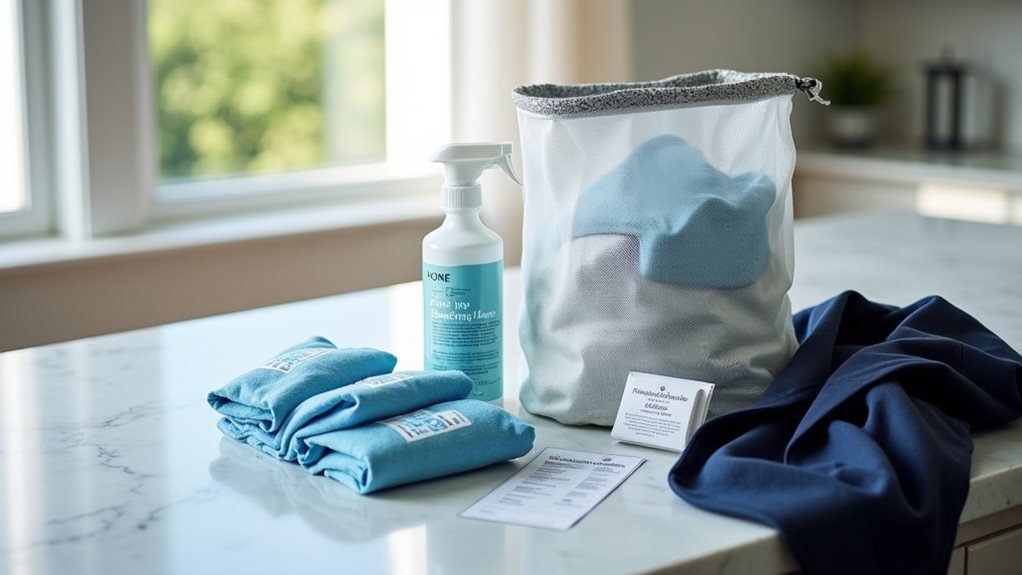Home dry cleaning kits transform your dryer into a cleaning powerhouse by using heat-activated cloths that create steam, which penetrates fabric fibers to dissolve dirt and eliminate odors without harsh chemicals. You’ll place pre-treated garments in a special dryer bag with a damp cleaning cloth, then run your dryer on medium-high heat for about 30 minutes – it’s honestly like magic watching wrinkled, smelly clothes emerge fresh and renewed. Keep exploring to master this game-changing laundry technique.
What Are Home Dry Cleaning Kits and Their Components
Convenience – that’s what drew me to home dry cleaning kits after I got tired of schlepping my favorite silk blouse to the cleaners every few weeks.
Honestly, these little miracle workers have become one of my best-kept laundry secrets. These kits come packed with everything you’ll need for the cleaning process: a stain remover for pre-treating spots, dryer-activated cleaning cloths that create gentle steam when heated, absorbent pads to protect your dryer, and a reusable dryer bag that transforms your regular dryer into a mini cleaning chamber.
While they’re perfect for delicate fabrics like silk and wool, don’t expect miracles with leather or velvet – those still need professional cleaning methods, unfortunately! 😅
Before using any home dry cleaning kit, always test the method on an inconspicuous area first to ensure it won’t damage your garment.
The Science Behind Steam-Based Cleaning Process
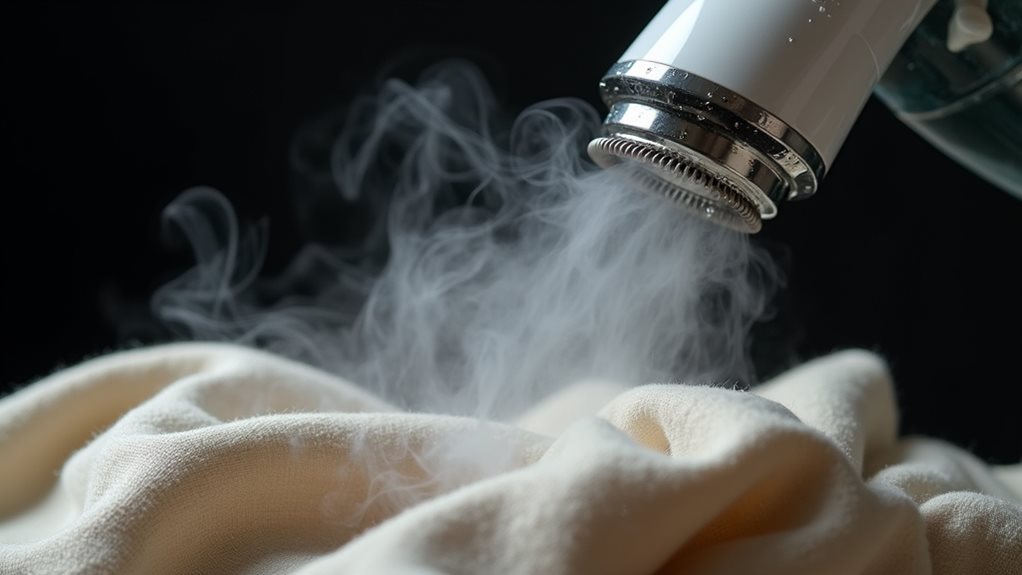
Now that you understand what’s actually inside these kits, let me explain the fascinating science that makes them work – because honestly, when I first learned how a simple dryer could replace expensive dry cleaning, I felt like I’d discovered some kind of household magic trick!
The steam-based cleaning process starts when your dryer’s heat activates that moist towelette, creating steam that penetrates deep into fabric fibers. This steam combines with cleaning agents to dissolve dirt and eliminate odors without harsh chemicals that could damage delicate fabrics.
It’s particularly effective for light stains and odor elimination, gently lifting grime from sensitive materials without the aggressive agitation that traditional washing requires. Home dry cleaning kits fundamentally mimic professional methods using heat and moisture instead of dangerous solvents.
This gentle approach helps maintain fabric integrity while providing an eco-friendly alternative to traditional dry cleaning solvents that can be harsh on both garments and the environment.
Step-by-Step Guide to Using Home Dry Cleaning Kits
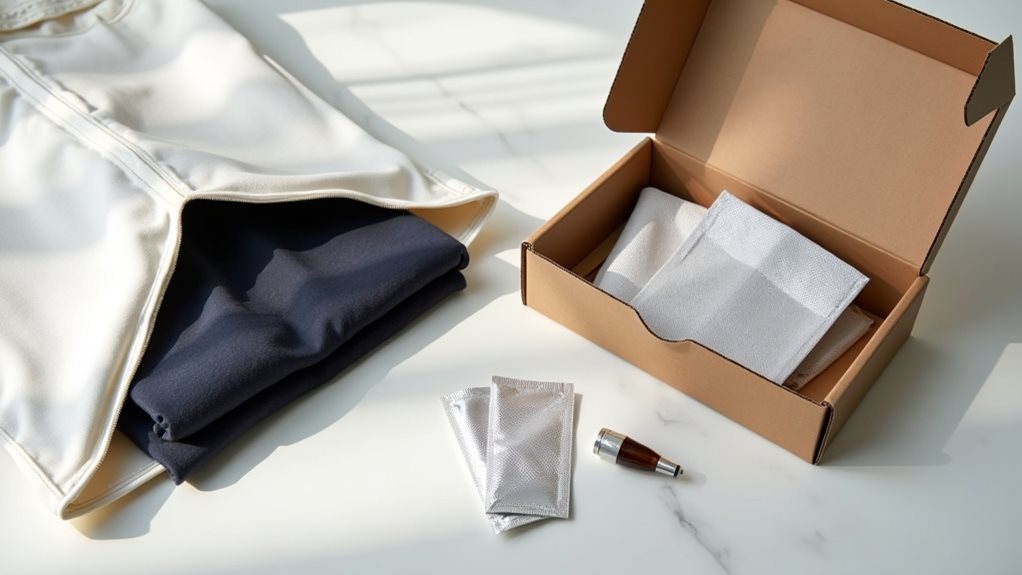
Although I’ll admit I was pretty intimidated the first time I opened one of these kits (seriously, why do they make the instructions so tiny?), using a home dry cleaning kit is actually straightforward once you break it down into manageable steps.
The pre-treatment process starts everything off right, and trust me, this step makes all the difference:
- Apply stain remover to problem areas and gently work it in with your fingers
- Use absorbent pads to blot and capture loosened dirt from garments before cleaning
- Place treated items in the dryer bag with the included damp cleaning cloth
- Run your dryer on medium to high heat for approximately 30 minutes
Once the cycle finishes, immediately remove everything and inspect them for any remaining stains.
Always follow the instructions exactly—your home dry cleaning kit cleaning removes more soil when you stick to the guidelines! 🧽
While home kits offer convenience, they work differently from professional dry cleaning since they don’t use chemical solvents like perchloroethylene that can effectively remove oil-based stains.
Effectiveness on Different Fabric Types and Stains
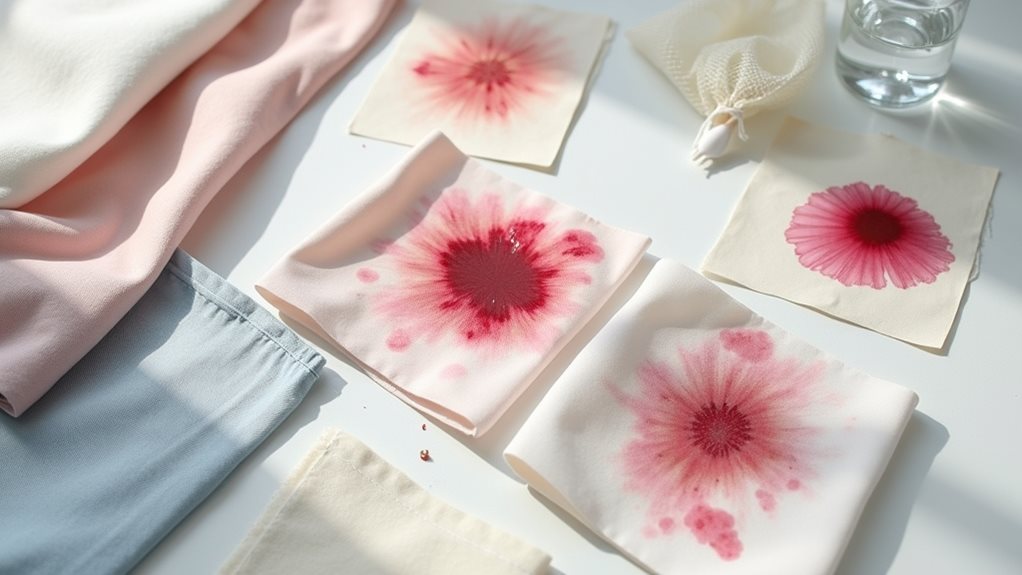
You’ll quickly discover that home dry cleaning kits work like that one friend who’s great at certain things but completely useless at others – they’ll refresh your favorite cashmere sweater beautifully, but ask them to tackle that red wine stain on your silk blouse, and you might end up with an expensive disaster.
The truth is, these kits shine with water-based stains and light cleaning on fabrics like wool and cotton, but they’ll leave you frustrated when facing oil-based stains or those “dry clean only” labels that seem to mock your DIY ambitions.
I learned this the hard way when I confidently threw my velvet blazer into a kit, only to realize that some fabrics need professional attention, no matter how much we want to believe otherwise 😅.
While home kits excel at removing light stains and odors using solvent-treated cloths and your dryer’s heat, they simply can’t match the powerful cleaning agents that professional services use for stubborn, embedded dirt.
Fabric Type Compatibility
When I first discovered home dry cleaning kits, I made the classic rookie mistake of assuming they’d work magic on every single fabric in my closet, only to learn through some unfortunate trial and error that understanding fabric compatibility is absolutely crucial for success.
These kits shine with natural fabrics like cotton, linen, and wool, where the dry cleaning solution works gently without harsh chemicals. Delicate fabrics such as silk and cashmere can benefit too, though you’ll want to proceed cautiously since results vary.
The cleaning agents excel at tackling water-based stains when you combine them with proper spot treatment beforehand.
However, avoid these fabric types entirely:
- Leather (steam damages the material)
- Velvet (heat ruins the texture)
- Fur (dryer heat causes irreversible damage)
- Heavy oil-stained items (limited effectiveness)
Unlike professional dry cleaning services that use controlled temperatures and specialized equipment to prevent shrinkage, home kits rely on your dryer’s heat settings, so always use low heat to minimize the risk of fabric contraction.
Stain Removal Limitations
Beyond understanding which fabrics work with these kits, I quickly discovered that the real test comes down to what types of stains you’re dealing with, and honestly, this is where my initial enthusiasm met some sobering reality checks.
While home dry cleaning kits excel at revitalizing delicate fabrics and tackling light stains, they’ll leave you disappointed when facing heavy grime or stubborn marks. The included stain remover works wonders with spot treatment on fresh spills, but old oil-based stains? Forget about it.
I learned this lesson the hard way with a beloved silk blouse that needed professional cleaning after my at-home attempts failed miserably. These kits have real cleaning capability limitations, so managing expectations becomes essential for success.
Professional dry cleaning uses specialized chemical solvents instead of water, making it far more effective at removing stubborn oil-based stains, grease, and makeup that home kits simply can’t handle.
Advantages and Limitations Compared to Professional Services
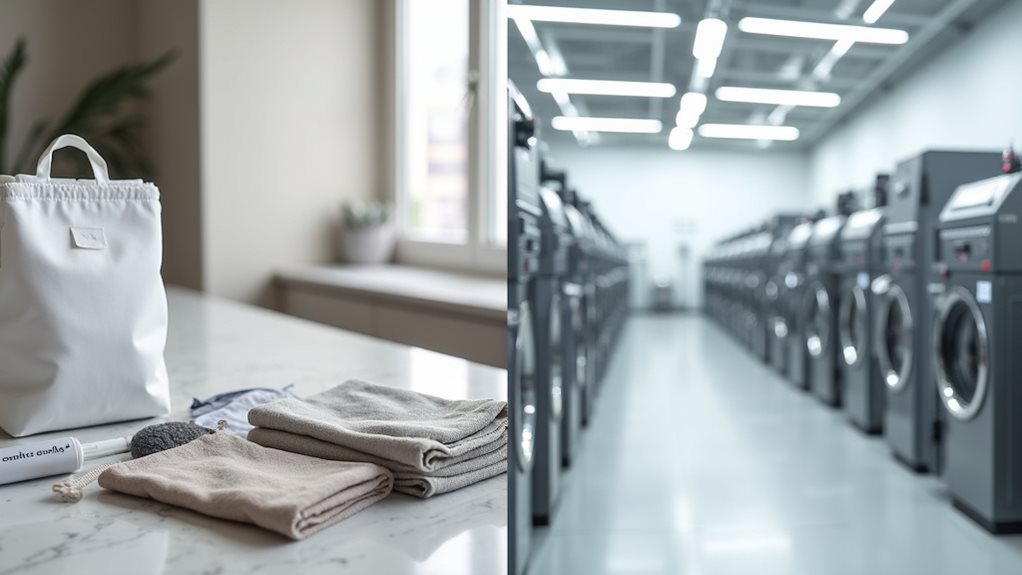
Although home dry cleaning kits can’t replace every aspect of professional services, they offer a compelling middle ground that’s transformed how I approach garment care in my own household.
Home dry cleaning kits have revolutionized my garment care routine by bridging the gap between convenience and professional-quality results.
While you’ll save money cleaning multiple garments for the price of one professional clean, you’re trading some effectiveness for convenience. These kits excel at revitalizing delicate fabrics and tackling light stains, but they can’t match the specialized solvents that professionals use for deep-set stains.
Here’s what you need to know:
- Cost advantage: Clean several garments for one professional service price
- Safety benefits: No harsh chemicals like perchlorethylene
- Convenience factor: Clean at home on your schedule
- Fabric limitations: Expensive materials like leather still need professional care
The steam-and-heat approach won’t give you that crisp, pressed finish either. Home kits work particularly well for maintenance cleaning between professional treatments, helping extend the lifespan of your garments while keeping costs manageable.
Best Practices for Optimal Results and Garment Care
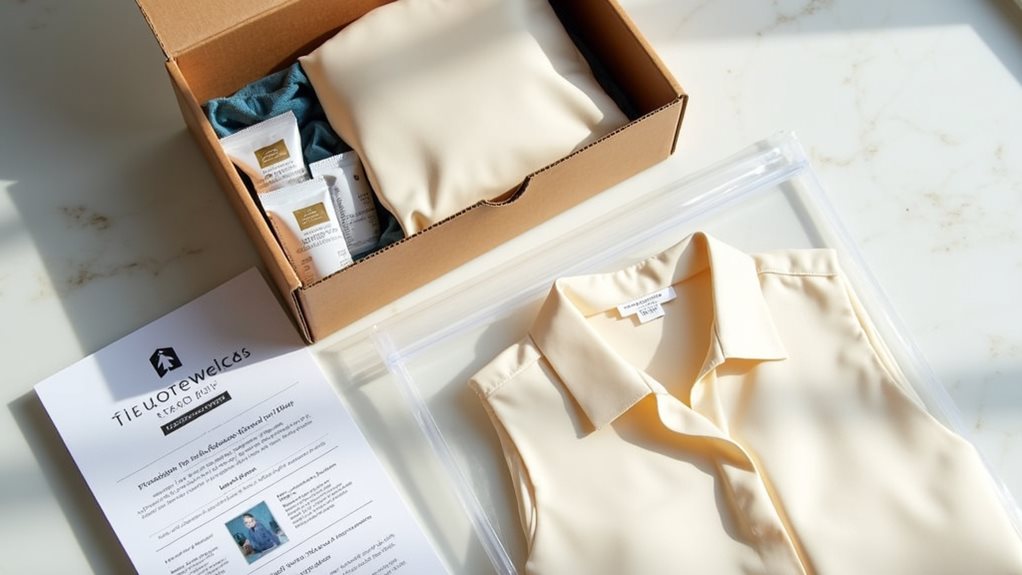
You’ve invested in a home dry cleaning kit, and now I’ll share the vital practices that’ll transform your results from “meh” to magnificent through proper preparation, smart dryer techniques, and careful post-cleaning care.
Trust me, after ruining my favorite blazer by skipping the prep work (rookie mistake! 😅), I learned that taking time with each step isn’t just helpful—it’s absolutely important for protecting your garments and getting that professional-quality finish at home.
Whether you’re dealing with delicate silk blouses or sturdy wool coats, mastering these three key areas will guarantee your clothes come out looking refreshed, wrinkle-free, and ready to make you feel confident every time you wear them.
Before diving into the cleaning process, always conduct a thorough garment assessment to determine which items can safely be cleaned at home versus those requiring professional treatment.
Proper Garment Preparation Steps
While I’ve made my fair share of dry cleaning disasters over the years, I’ve learned that proper preparation truly makes the difference between garments that come out looking refreshed and those that emerge looking, well, like they’ve been through a tumble dryer tornado 🌪️.
Effective garment preparation for home dry cleaning requires attention to detail that’ll save you heartache later:
- Inspect thoroughly – Check for heavy stains that need professional treatment before using your kit
- Pre-treat strategically – Apply stain remover and use absorbent pads to capture dirt effectively
- Secure everything – Close all buttons and zippers to maintain shape during the cleaning process
- Group similar fabrics – Sort by weight and color to prevent color bleeding and optimize results
Always follow manufacturer’s instructions carefully, especially regarding temperature settings for delicate fabrics. Before starting any home dry cleaning process, always check garment care labels first to ensure the item is suitable for at-home treatment rather than professional dry cleaning.
Optimal Dryer Settings
Getting the dryer settings right can feel like deciphering some ancient laundry code, but once you master these fundamentals, your home dry cleaning results will transform from “meh” to magnificent.
Start by cleaning your dryer lint filter – trust me, this simple step dramatically improves cleaning efficiency and steam circulation. Set your heat to medium-high for ideal cleaning results, which creates the perfect steam environment.
Group similar fabric weights and colors together in the cleaning bag, avoiding overstuffing that restricts movement. I learned this lesson after finding my silk blouse looking like a crumpled napkin!
Follow the manufacturer’s instructions for drying time, typically thirty minutes, guaranteeing your garments emerge refreshed and wrinkle-free. This approach not only saves you time and money but also reduces chemical usage compared to traditional dry cleaning methods.
Post-Cleaning Garment Handling
The moment your dryer timer dings, that’s when the real magic begins, because what you do in those first few minutes after removing your garments can make or break your entire home dry cleaning experience.
Post cleaning garment handling isn’t just busywork—it’s your secret weapon for achieving that professional polish you’re craving.
Here’s your game plan for ideal results:
- Hang immediately to prevent wrinkles settling into fabric fibers
- Inspect cleaned items thoroughly for stains, loose buttons, or torn seams
- Address repairs promptly while issues are manageable and fixable
- Store cleaned garments in a breathable garment bag for freshness
Don’t forget ironing garments when needed—that extra step transforms “homemade” into “dry cleaner quality.”
And please, clean your lint filter religiously! 🧽

